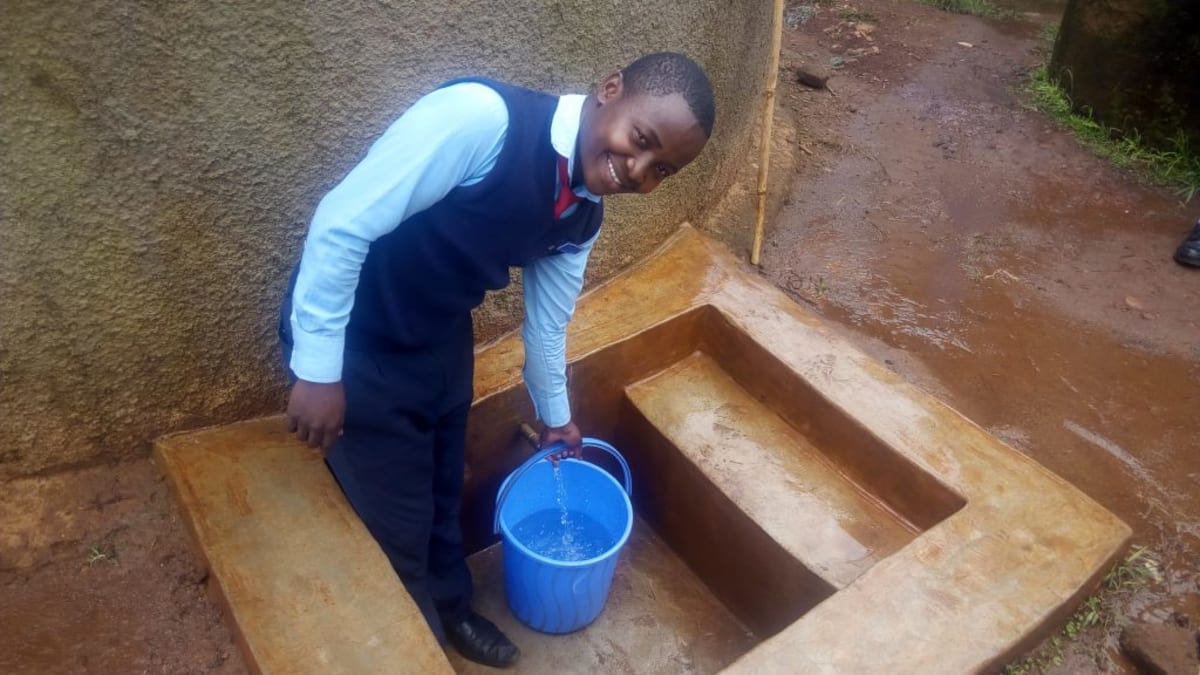This project is a part of our shared program with Western Water And Sanitation Forum (WEWASAFO). Our team is pleased to directly share the below report (edited for clarity, as needed).
Welcome to the School
Ebubayi Secondary School has a mix of overnight boarders who stay in dormitories, and day scholars who arrive every morning at 6:50am. They then join the residents in cleaning classrooms and school grounds until 7am when morning study hall begins.
On Wednesdays, the students gather together with their teachers in an assembly hall to have their guidance and counseling sessions. These cover a vast number of challenges that students face as adolescents, and equips them with tools to overcome.
Student enrollment is at 600, comprised of 240 girls and 360 boys. The school employs 42 teachers and 16 support staff. (Editor's Note: While this many people may have access on any given day, realistically a single water source can only support a population of 350-500 people. This community would be a good candidate for a second project in the future so adequate water is available. To learn more, click here.)
Water Situation
There have been a few plastic tanks donated to the school, but these have a small capacity that even when full, the rainwater can only serve the students for a day. Since the school has no other water source, they have had to pay dearly to continuously purchase water from metered kiosks. They also have to pay local laborers to transport the water to and from the kiosks!
When delivered, this water is poured into large drums kept in and by the kitchen. Different amounts are rationed depending on whether a student is a boarder or day scholar. Though this water is clean because the government chlorinates it, the strict allowance of water causes a huge strain on both school environmental hygiene and students' personal hygiene.
The headteacher says that virtually no female students board at the school because they can't get by with the little water available. They're all boys! The boys here are achieving much higher scores because of they get to live where they study.
Sanitation Situation
There are 20 pit latrines that are in decent structural condition, but are almost full. But since there isn't much water here, the latrines are also filthy! Students don't have the water they need to wash the latrine floors as needed. There are also 14 stalls that provide privacy for the boarders as they wash up.
However, there are no hand-washing stations here - students do not wash their hands after using the latrines or before eating. Principal Veronica Onacha told us that "the school nurse is always dealing with diarrhea and stomachache cases which can be attributed to the lack of water to clean utensils well and to wash hands after visiting the toilets!"
Plans: Hygiene and Sanitation Training and Hand-Washing Stations
Training will be held for two days. The facilitator will use PHAST (participatory hygiene and sanitation transformation), ABCD (asset-based community development), CTC (child to child), lectures, group discussions, and handouts to teach health topics and ways to promote good practices within the school. The CTC method will prepare students to lead other students into healthy habits, as well as kickstart a CTC club for the school. This CTC club will oversee the new facilities, such as hand-washing stations, and make sure they are kept clean and in working condition. The two hand-washing stations will be delivered to the school, and the club will fill them with water on a daily basis and make sure there is always a cleaning agent such as soap or ash.
Plans: VIP Latrines
Two triple-door latrines will be constructed with local materials that the school will help gather. Normally, three doors would be given for each gender, but in this case the school has requested that all six be given to girls. And with a new source of water on school grounds, students and staff should have enough to keep these new latrines clean.
Plans: Rainwater Catchment Tank
A 50,000-liter rainwater catchment tank will help alleviate the water crisis at this school. The school will also help gather the needed materials such as sand, rocks, and water from the spring for mixing cement. Once finished, this tank can begin catching rainfall that will be used by the school’s students and staff. The school will no longer have to purchase expensive water from kiosks and ration it, but instead will have enough clean water of their own available on school grounds.
We and the school strongly believe that with this assistance, standards will significantly improve. These higher standards will translate to better academic performance, especially for the girls!

 Rainwater Catchment
Rainwater Catchment
 Rehabilitation Project
Rehabilitation Project

































